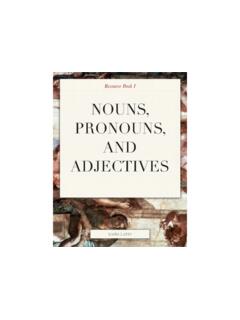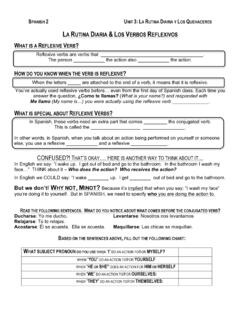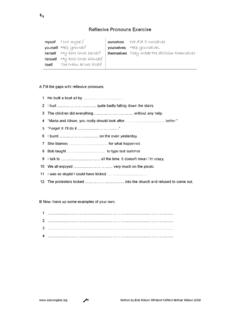Transcription of Unit Plan - Ms. Scislowicz's Spanish Class
1 Unit Plan Vamos a viajar! vTravel vocabulary vDirect object pronouns vCosta Rica Claire Scislowicz Fall Semester 2015. Student Teacher at Rochester High School Spanish 2 (Freshmen and Sophomores). 2. Description of Learning Environment Rochester High School is one of three high schools in the Rochester Community Schools district, located in Rochester Hills, Michigan. In 2014, the racial profile of students and staff was out of 1643 individuals total. From this number, 1177 were white, 144 were African American, 182 were Asian Hispanic, 77 were American Indian, 1 was Pacific Islander, and 53 were two or more races. Out of the three high schools in Rochester Community Schools, there is no denying that Rochester High contains the highest minority population and diversity.
2 The racial make-up definitely impacts the level of education. For example, classrooms with a lot of diversity provide the opportunity for students to think critically and discuss distinctive cultures in depth. Also, the population of many minority students can lend itself to teaching tolerance and acceptance of all races. At Rochester High, the total minority enrollment is 27 percent, which has remained at this level for the past 3 years. In addition, the school is home the English language learner's program for the district for grades 9-12, and has 43 different languages represented. Today, the high school serves over 80 students who may be scheduled for direct instruction of English and/or for academic support in English. My student teaching experience has been in Spanish 5AP, Spanish 4, and Spanish 2.
3 Classes. Therefore, I have taught freshmen, sophomores, juniors, and seniors. The Spanish 5AP. curriculum is extraordinary because it focuses on six major world themes: families and communities, global challenges, beauty and aesthetics, contemporary life, personal and public identities, and science and technology. These themes are extremely relevant for students, which make our Class discussions and participation very engaging. As far as the Spanish 4 curriculum, so far, I have taught about the Camino de Santiago in Spain, the work world and its vocabulary, reflexive verbs, verbs with prepositions, double object pronouns , and commands. Finally, for Spanish 2, I completed my unit on travel vocabulary, direct object pronouns , and the culture of Costa Rica. My students at Rochester High have a wide variety of interests, skills, and knowledge.
4 For example, sports, band, music, technology, and travel are all interests that many of my students hold. Students in each level started the year with a solid foundation of Spanish from the previous year. Even my Spanish 2 students retained a lot of basic grammar from Spanish 1. With respect to my learners' current levels of proficiency based on the ACTFL Proficiency Guidelines, overall I would classify Spanish 5AP students as intermediate low-mid, Spanish 4. students as novice high-intermediate low, and Spanish 2 students as novice low-mid. Before I began my travel unit in the Spanish 2 classes, I found out what my students'. previous experiences were with the content. Most students had been exposed to direct object pronouns at the end of Spanish 1, but did not retain the grammatical structures.
5 In relation to the travel vocabulary, they needed the background information of going to an airport to travel. Some students were still confused about the meanings of a boarding pass, itinerary, and customs, so I. thoroughly explained these terms to them at the beginning of the unit to avoid further confusion. A few of my Spanish 2 students have learning disabilities or special needs so I accommodated for them by providing multiple modalities for vocabulary and practice sentences. My PowerPoint with travel vocabulary words as well as direct object pronouns included a plethora of visuals and written examples for these students. 3. Overview of the Instructional Design Title of the unit: Vamos a viajar! Duration of the unit: Two weeks Thematic context: Travel vocabulary, direct object pronouns , and Costa Rican culture ACTFL Standards: o Communication Standard : Students engage in conversations, provide and obtain information, express feelings and emotions, and exchange opinions.
6 O Communication Standard : Students understand and interpret written and spoken language on a variety of topics. o Comparisons Standard : Students demonstrate understanding of the nature of language through comparisons of the language studied and their own o Comparisons Standard : Students demonstrate understanding of the concept of culture through comparisons of the cultures studied and their own o Culture Standard : Students demonstrate an understanding of the relationship between the practices and perspectives of the culture studied. o Culture Standard : Students demonstrate an understanding of the relationship between the products and perspectives of the culture studied. Unit Level Objectives: o Students can use the new vocabulary words to answer personal questions about travel.
7 O Students can evaluate and decipher the meanings of Spanish clues to match vocabulary words with each one. o Students can state the correct vocabulary word based on visuals from the PowerPoint. o Students can listen, watch, and comprehend new vocabulary words in context from an authentic Costa Rica video. o Students can infer and hypothesize about the culture of Costa Rica (food, music, animals, sports, attractions, etc.). o Students can demonstrate an understanding of Costa Rican culture based on the PowerPoint. o Students can answer comprehension questions about Costa Rica based on the information/facts and video from the PowerPoint. o Students can complete a crossword puzzle with Spanish clues based on review from the new travel vocabulary words. o Students can replace nouns in sentences using DOPs based on the information on the PowerPoint.
8 O Students can say what someone does, what someone is going to do, and what someone is doing using DOPs and the present tense, simple future, and present progressive. o Students can form responses using DOPs based on visuals from a PowerPoint. o Students can apply the DOP rules to complete a practice worksheet with Spanish sentences in different tenses. Critical thinking skills developed and how: Every Spanish lesson in this unit required critical thinking skills, whether these skills were figuring out Spanish vocabulary words in an authentic context, conjugating verb tenses correctly in order to write and speak about the present or simple future tense, applying grammar rules in both written and verbal practice, or answering comprehension questions based on a listening practice.
9 It is so fundamental to vary the types of instruction and assignments to include speaking, listening, reading, and writing practice. In each lesson, I tried to provide all modes of communication so students 4. were able to fine-tune their critical thinking skills. At the end of the unit, students succeeded in applying everything they learned about travel vocabulary, direct object pronouns , and the culture of Costa Rica to create Tellagami's and projects based on trips to Central America. o Student evidence of critical thinking skills: Tellagami Examples: Central America Project Example: prezi/?utm_campaign=share&utm_medium=cop y Authentic texts used in the unit: o Video of a travel agency in Costa Rica from Avancemos 2 textbook video o Video of Discover Costa Rica from YouTube link: o Spanish songs using direct object pronouns in the titles: Mientras t me amas Justin Bieber B salo adios The Nylons Mientras yo te tengo Mark Roach Yo la amaba primero Heartland Ll mame quiz s Carly Rae Jepson De toda manera que t lo quieres Journey Ven y t malo Selena Gomez D jalo ir Idina Menzel D jalos ser peque os Lonestar Porque t me amabas Celine Dion o AT&T Spanish Commerical with DOP Examples: Technology integration.
10 O Espon Projector o PowerPoints o Kahoot game with cell phones o Tellagami App o Music on YouTube Cultural or interdisciplinary connections made: Students learned all about the culture of Costa Rica through a PowerPoint and anecdotes from my CT (since she has traveled there). They learned about the location, history, food, president, sports, animals, people, health care, education, and attractions in Costa Rica. The students actually voted to have a quiz on this information because they felt so confident with the material and it was a subject that interested a majority of students who typically struggle with grammar or memorization. In addition, interdisciplinary connections with geography and world history were made when we discussed the location and surrounding areas of Costa Rica as well as its history with other countries.







